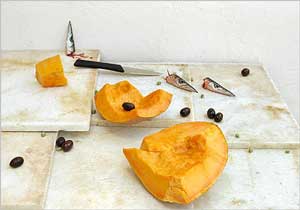Still life with camera
Works leave viewer asking: Is that a photo or painting?
by Steve Bennett, S.A. LIFE

Bread House
A House Made of Food: Bread House is included in photographer David Halliday’s exhibition ”Culinary Delights” at the San Antonio Museum of Art.
Warm light falls on an old country table, illuminating a bowl full of eggs and grapes in soothing earthy tones. It is a tranquil scene, artfully and painstakingly arranged, sensual, sublime.
“It’s like an Old Master painting, Caravaggio or something,” says David Rubin almost reverentially as if he’s in church.
Perhaps Rubin, who is curator of contemporary art at the San Antonio Museum of Art, resorts to devout or deferential as a default mode in this, his Jones Avenue temple. But the work of New Orleans photographer David Halliday does have a way of inviting a viewer in for quiet, prayerful contemplation.
Rubin has gathered 31 of Halliday”s images of edibles — highly orchestrated scenes of fruits, vegetables, eggs, fish, dated 1995 to 2007 — in an exquisitely gorgeous exhibition titled “Culinary Delights”.
No one will long mistake the silver gelatin print titled Uva/Uovu (Grapes/ Eggs) for anything but a photograph. Yet there is that fleeting moment of first encounter, in which the mind’s eye clicks like a camera shutter and the brain registers its sepia tones, when you wonder just how this magical image was made.
“I’m certainly not trying to make paintings, although I do look at a lot of paintings,” says Halliday, 51, who is originally from upstate New York but moved to the Crescent City in 1991 — as a chef. “I see them (his food subjects) as beautiful, intimate objects and treat them that way. I do objectify them … I try to focus on the content before the medium, but I want the viewer to ask, as a secondary question, ”Is that a photograph or a drawing?””
Not all is muted and mock-masterful here. Rubin compares Still Life With Durian Fruit, with its pinwheel of bananas and spiky and oblong shapes, to Brancusi’s modernist sculpture. Halliday’s 2000 series of shadowbox images — he placed objects inside an antique Italian cookie jar — arc not only “anthropomorphic,” Rubin says (check out Cauliflower) but “sort of Joseph Cornell.”
A Cutting Image: Ordinary objects create an extraordinary scene of juxtaposition in Fish Heads and Pumpkins(2007).

Fish Heads and Pumpkins, 2007
“Once the objects went into that box they became specimens,” Halliday says. “It was almost like Alice through the looking glass.”
More recently, Halliday, who shoots on film (although he computer- edits, comparing the process to a traditional dark room), has devoted energy to eye-popping color.
Fish Heads and Pumpkins (the artist has a great sense of juxtaposition; we also get Zucchini and Tangerines and Lemon and Black Olive) is like a scene of devastation after a battle: severed fish heads, barbed and bloodied, chunks of smashed pumpkin, guts revealed. An evil paring knife lurks in the background.
And is there something sexual about Carrots, Crossed (carrot afterglow) and Yellow Squash (vegetable orgy)? Right, probably not.
Halliday, who studied photography in the late ”70s at the prestigious Newhouse School at Syracuse University, gave up the camera for the kitchen in the ’80s.
“I was in the photo-journalism program and wasn”t really suited for it,” he says of college. “I went to New York to look for a job, and it ended up being in a kitchen.”
He made the move to New Orleans nearly 20 years ago at the behest of a friend to work at the award-winning Bistro Maison de Ville in the French Quarter.
According to Rubin, that same year, Halliday came across a scene of stacked hatboxes in a Victorian home that the artist recalls as “romantic unto itself” and felt compelled to document it.
Of the earliest image in “Culinary Delights”, 1995’s Banana (Diptych), a two-panel sepia-toned view of a bunch of bananas on a long stalk, presented horizontally, Halliday recalls saying to himself, ” ”I’m just going to photograph those bananas.” That’s all there was to it.”
Since 1992, the artist has had exhibitions at galleries in New York, San Francisco, New Orleans and Atlanta. His portfolio also includes portraits — nudes, landscapes and still-lifes of objects other than porcini and octopi.
Octopus, a box series shot in “Culinary Delights”, haunts. Like almost every image in the exhibition, it has more to do with art than eating. (In fact, only one image here — 2007’s Five Fish — seems suitable for the cover of Saveur or Food & Wine). Unlike the photographer himself, the work emerges from an artistic tradition rather than the kitchen.
